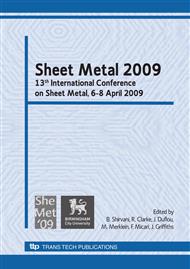p.421
p.429
p.439
p.449
p.459
p.467
p.473
p.481
p.493
The Effects of Thickness on the Formability of 2000 and 7000 Series High Strength Aluminum Alloys
Abstract:
This paper studies the effects of sheet thickness on the forming limits of high strength aluminum alloys commonly used in the aircraft industry. The selected materials are 2024-T3 and 7075-T6 representing 2000 and 7000 series aluminum alloys. Two sets of experiments are carried out to identify the effects of sheet thickness on the forming behavior of the selected alloys. The first set of the experiments is tensile testing. The tensile properties of sheets with different thickness and different materials including the plasticity parameters are determined in the first set of experiments. The second set of the experiments is air bending. The minimum bending radius of the different series of materials is determined in the second set of experiments. The results of the tensile testing and air bending are studied both separately and in comparison with each other to identify the trends and to understand the mechanisms governing the observed trends. It is shown that the behavior of the studied alloys is to some extent different from the behavior of more ductile aluminum alloys and mild steels.
Info:
Periodical:
Pages:
459-466
Citation:
Online since:
March 2009
Authors:
Keywords:
Price:
Сopyright:
© 2009 Trans Tech Publications Ltd. All Rights Reserved
Share:
Citation:


